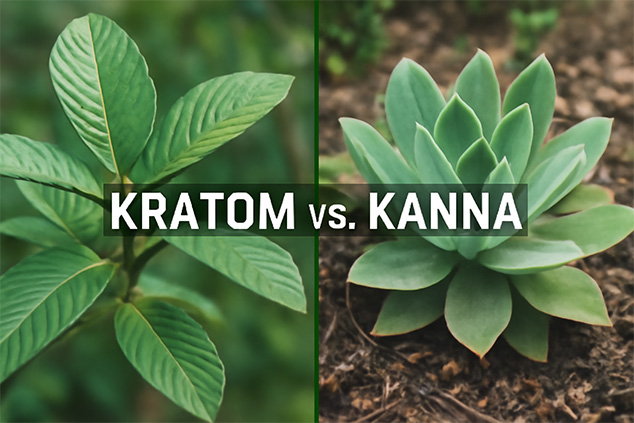Kanna and kratom may both seem like completely different and unrelated herbs. Yet, there are actually quite a few similarities between them. So, let’s jump into the details and find out who wins the canna vs. kratom battle. Which is superior analgesic, relaxant, and anxiety reliever?
What Is Kanna?
Kanna, scientifically known as Sceletium tortuosum and also called Channa or Kougued, is a flowering succulent plant that commonly grows in South Africa. The name of this plant literally means “something chewable” or “something to chew on.”
Historically, hunter-gatherers in South Africa chewed kanna for mood-altering. It is still possible to chew it now; however, it is also available in powder form in gel capsules, as well as in tinctures and teas. Some people also prefer to smoke it.
The Effects of Kanna
Traditionally, the herb has been used to relieve stress, tension, anxiety, and depression. Kanna can also be used as a pain-reliever and can reduce hunger.
Kanna effects depend on the dosage. Taken in small doses, kanna is a stimulant. In moderate doses, it becomes euphoric, while in large doses, it is sedating. Certain sources may claim that kanna is hallucinogenic. Yet, that is not accurate.
The beneficial effects of kratom are due to alkaloids it possesses. Some of the alkaloids are mesembrine, mesembrenone, mesembrenol, and turtuosamine.
Kanna is a serotonin reuptake inhibitor, working in a way similar to anti-depressants. It is also a cannabinoid agonist, which signifies that it interacts with cannabinoid receptors in the human brain in a way that is similar to that of CBD and marijuana.
In addition to the beneficial alkaloids, the succulent also contains oxalates. Oxalates or oxalic acid are organic compounds that many plant foods have. These compounds are known as anti-nutrients. That is because they bind to calcium and other minerals and can reduce their absorption by the body.
This is common with foods like spinach and kale, which contain similar levels of oxalates to what kanna does. So, in the case of spinach, for instance, consuming it raw can prevent the body from being able to absorb calcium. As a result, despite spinach being rich in calcium, the body is unlikely to absorb all of it.
While it’s not very common, oxalates can also form kidney stones, especially in people with weaker digestive systems.
What Is Kratom?
While kanna is a small succulent plant, kratom is a tall tropical tree. It commonly grows in Southeast Asian countries, including Indonesia, Thailand, Malaysia, Myanmar, and Papua New Guinea.
Ground-up kratom leaves yield a fine powder, which is available for sale in bulk powder form as well as in capsules, extracts, and resin.
The Effects of Kratom
Kratom has also been in traditional medicine for centuries. People in Southeast Asia used it to boost energy, treat colds and diarrhea, and more. Yet, the most popular and prominent benefit of kratom is its powerful pain relief.
The effects of kratom result from its alkaloids. While mitragynine and 7-hydroxymitragynine are the most abundant ones and responsible for most of the effects, kratom has at lear 25 total alkaloids and 40 total compounds. Yet, the full alkaloid profile and their scope of effects are yet to be determined through more scientific studies.
7-hydroxymitragynine is a powerful alkaloid that is approximately 13 times stronger than morphine in relieving pain. 7-hydroxymitragynine and other alkaloids interact with the opioid receptors in the brain.
Kratom is also dose-dependent. In low doses, it has stimulant properties and can boost mood and concentration. In moderate doses, the herb is moderately stimulating and pain-relieving. It also boosts the mood and creates a calm and steady focus. In large doses, however, it is a potent analgesic and relaxant. Moderate and low doses of certain kratom strains can be effective in relieving stress, anxiety, and depression.
It is important to accurately dose kratom as an excessive dose can lead to unpleasant side effects like nausea and vomiting. Yet, unlike common claims, kratom is not an opioid, nor it is addictive or a dangerous drug.

Kanna vs. Kratom: Which Should You Choose?
Kanna vs. Kratom: Effects
While some effects of the herb overlap, kratom offers more versatility than kanna. That is because kratom comes in a variety of strains and vein types. Each strain and vein come with a unique alkaloids profile and result in slightly different effects,
The most beneficial way of taking kratom long-term is rotating strains. This means that you take different strains of kratom on different days. As a result, this keeps kratom tolerance low and the user can experience variations of the herb.
Since some of the effects overlap, kanna can serve as an alternative to kratom when the user is taking a break. That is due to the mild pain relief that kanna provides. Nonetheless, frequent kratom users, especially those with intense chronic pain who take red strains, may find that kanna does not have the same potency as kratom.
Kratom may also be a more effective herb for more severe health conditions such as PTSD, cancer, Lyme disease, and similar.
Kanna vs. Kratom: Side Effects
While both herbs are generally safe, excessively high doses can lead to unpleasant side effects. In the case of kanna, this can be diarrhea, drowsiness, high blood pressure, and headaches. People with kidney stone issues and weak digestion should also be cautious when taking kanna products due to high oxalate level.
In addition to that, you should not take kanna if you take any form of SSRI, regardless of whether it is a natural herbal product or prescription medication. This can lead to serotonin syndrome, a condition when levels of serotonin are too high. It can lead to agitation, confusion, increased heart rate, muscle twitching, excessive sweating, diarrhea, and even death in very severe cases.
The most common side effect of regular kratom use is constipation. Therefore, it is important to consume lots of liquids and fiber. High kratom dosage can also lead to nausea, vomiting, and headaches.
Yet, one thing is common – neither one of the herbs is as bad as some sources imply.
Kanna vs. Kratom: Legalities
While kanna is legal in the US, kratom isn’t legal everywhere. Certain states, cities, and counties have banned kratom products. Other states, however, are moving towards passing the Kratom Consumer Protection Act, legislation that ensures that kratom sales and distribution are regulated by state law and safer for buyers.
Due to restricted kratom legality, people in certain locations may benefit from kanna’s similar relaxing and pain-relieving effects.
Have you tried both kratom and kanna? When it comes to kanna vs. kratom, which herb do you prefer and would recommend and why?



Leave a Reply